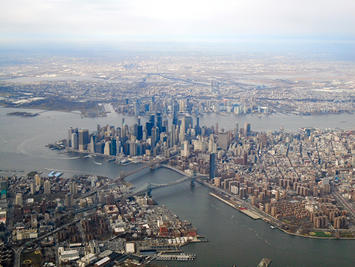
This may come as a surprise, but bicycles provide more 30-minute job access than transit for the average worker in 50 large metropolitan areas (combined). This is evident from data produced by the University of Minnesota Accessibility Laboratory. The 50 metropolitan areas all have more than 1,000,000 population, though do not include Memphis, Grand Rapids or Tucson, the three others of that size. Reports have been produced for job access, by travel time for the average worker in the metropolitan areas.
Bicycle job accessibility estimates are provided for the “low-stress” and “medium stress” traffic, which are defined in detail at http://cts.umn.edu/Publications/ResearchReports/pdfdownload.pl?id=3088, page 3. Overall, bicycle access is far less at “low-stress,” with a grand total of 516,000 jobs accessiblein less than 30 minutes. Medium stress bicycle access for 30-minutes stands at 1,670,000.
Medium Stress Bicycling and Transit Job Access
Access data is provided in 10 minute increments up to 60 minutes and longer. Bicycles have a strong advantage in the lower travel time medium stress categories. For example, for a commute of 10 minutes or less, bicycles provide more than six times the job access of transit. At 20 minutes the bicyclist can reach triple the number of jobs as the transit commuter. In less than 30 minutes bicycles reach 1.74 times as many jobs as transit. This travel time, 30-minutes, has become a standard for analysis, and is greater than the average overall one-way commute time of 27 minutes.
The bicycle retains its advantage up to 40 minutes, reaching 1.17 times as many jobs as transit. At 50 minutes, as well as at 60 minutes and over, transit reaches more jobs than bicycles (Figure 1).
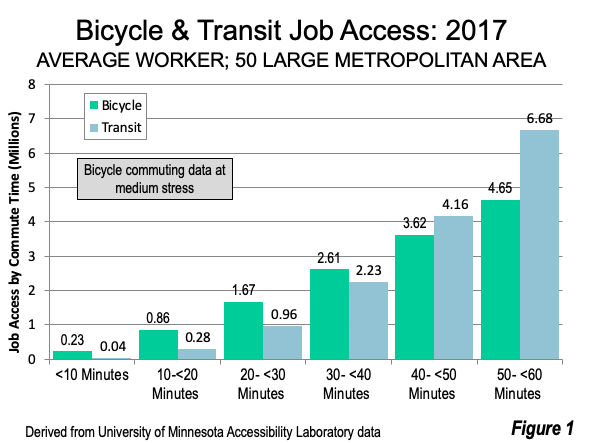
Highest 30-Minute Bicycle Commute Markets Compared to Transit
Bicycles provide greater 30-minute job access than transit in 49 of the 50 metropolitan areas.
Top ranking Detroit and second ranked Tampa-St. Petersburg have the strongest 30-minute bicycle to transit access ratios out of the 50 metropolitan areas, at approximately 4.2. In Columbus and Jacksonville, bicycle commuters can reach 3.5 times as many jobs as by transit. In the six other metropolitan areas in the top 10, bicyclists can reach more than three times as many jobs as by transit. These include Phoenix, Cincinnati, Minneapolis-St. Paul, Orlando, Denver and Salt Lake City (Figure 2).
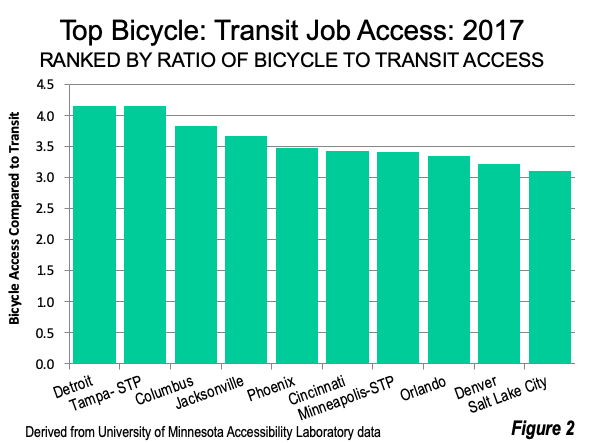
Smallest 30-Minute Bicycle Commute Markets Compared to Transit
Bicyclists in the Dallas-Fort Worth metropolitan area have 30-minute access to only 65% of the jobs that can be reached by transit, the least among the 50 metropolitan areas. Dallas-Fort Worth is the only metropolitan area in which bicycle access is less than transit.
New York, centered around the nation’s dominant transit legacy city, with its especially high residential and employment densities, has the second lowest 30-minute bicycle access to transit access ratio, at 1.05. This weaker bicycle rating is not surprising, given that the New York metropolitan area has an incomparably more comprehensive transit system than anywhere else in the nation.
Philadelphia, also with a strong transit system and with a transit legacy city, has the third smallest ratio of 30-minute bicycle to transit access, at 1.08. The balance of the ten metropolitan areas where bicycles have the least access compared to transit includes Hartford, Providence, St. Louis, Boston, Virginia Beach (Norfolk), Los Angeles and Washington (Figure 3).
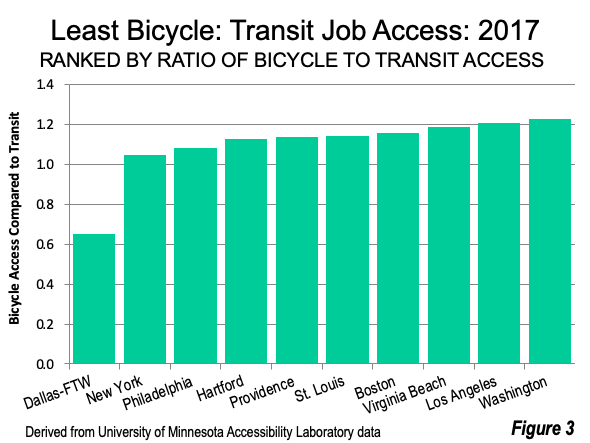
Strongest Bicycle Commuting Volumes
The three metropolitan areas in which there is the greatest 30-minute job access include transit legacy cities. Overall there are six transit legacy cites, occupying only part of their metropolitan areas, combine for nearly 60 percent of all the transit commuting destinations in the nation.
With its high urban core population and the largest central business district, it is not surprising that the most jobs can be reached by bicycle in 30-minutes in New York. Bicyclists can reach 223,000 jobs, while transit commuters can reach 213,000 jobs. San Francisco, with the second highest density core municipality in the nation, and the fourth largest central business district has the second highest 30-minute job access. On average, 127,000 jobs can be reached on bicycles and 81,000 on transit. Chicago, also with densely urbanized core and the second largest central business district has 84,000 jobs accessible with 30-minute bicycle access, compared to 54,000 for transit.
Denver and Portland, metropolitan areas without transit legacy cities and with smaller transit systems rank fourth and fifth in 30-minute bicycle access. They are followed by Washington, Minneapolis-St. Paul, Seattle, San Jose and Boston. Washington and Boston contain transit legacy cities (Figure 4).
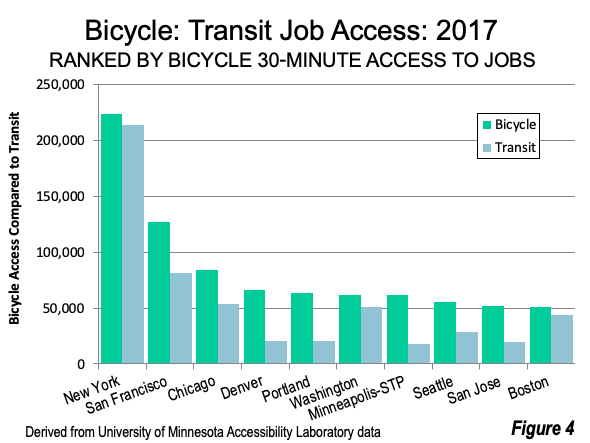
Will Bicycles Attract More Transit Riders?
Despite their considerable actual 30-minute access advantage over transit, only 820,000 commuters used bicycles, regardless of their travel times, less than the nearly 1.4 million transit commuters who reached work in 30 minutes. The need to drop children or day care diminishes the bicycle market, as do other factors, like weather, health and more.
Of course, transit ridership has suffered a catastrophic decline due to the COVID-19 pandemic. Data from last week indicates that BART ridership (San Francisco) continued to be down 89% on weekdays on Tuesday, August 18. New York City subway ridership continued to be down more than 75% on Monday (August 17) and Tuesday (August 18), as was also the case with the Long Island Railroad. The other New York state based commuter rail system, the Metro-North Railroad, was down more than 80%.
Concerns have been raised about the health safety of transit, as economies begin to open up. For example, 74% of commuters comfortable about returning to their physical offices were “very or extremely concerned about using transit, according to the Ottawa Citizen.
In this climate bicycles have provided a welcome substitute means of transport for many transit commuters, both here and around the world. Statistics Canada reports that 34% of transit commuters have switched to another mode of transport, with three quarters using cars and one-fifth switching to bicycles and walking, while 42% switched to telework. Bicycle counts are up on New York’s East River Bridges (photo above). Bicycles are increasingly hard to get in many places, driven by both fear of transit and a desire to exercise.
There are likely to be COVID related behavioral changes, when life returns to normal. Experts think that telework will retain a higher share of commuting than it did before. Perhaps bicycles will play a growing role are well.
Photograph: New York East River Bridges, by the author.
Wendell Cox is principal of Demographia, an international public policy firm located in the St. Louis metropolitan area. He is a founding senior fellow at the Urban Reform Institute, Houston and a member of the Advisory Board of the Center for Demographics and Policy at Chapman University in Orange, California. He has served as a visiting professor at the Conservatoire National des Arts et Metiers in Paris. His principal interests are economics, poverty alleviation, demographics, urban policy and transport. He is co-author of the annual Demographia International Housing Affordability Survey and author of Demographia World Urban Areas.
Mayor Tom Bradley appointed him to three terms on the Los Angeles County Transportation Commission (1977-1985) and Speaker of the House Newt Gingrich appointed him to the Amtrak Reform Council, to complete the unexpired term of New Jersey Governor Christine Todd Whitman (1999-2002). He is author of War on the Dream: How Anti-Sprawl Policy Threatens the Quality of Life and Toward More Prosperous Cities: A Framing Essay on Urban Areas, Transport, Planning and the Dimensions of Sustainability.












